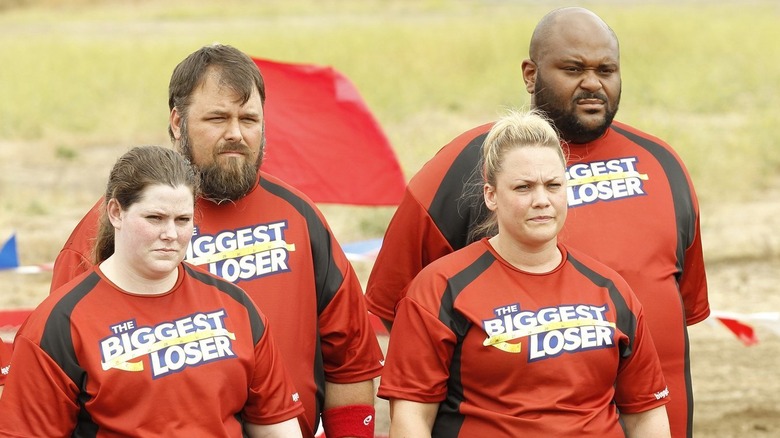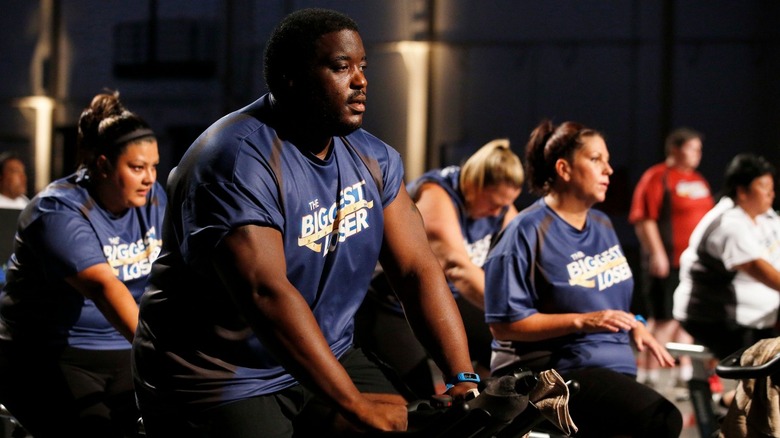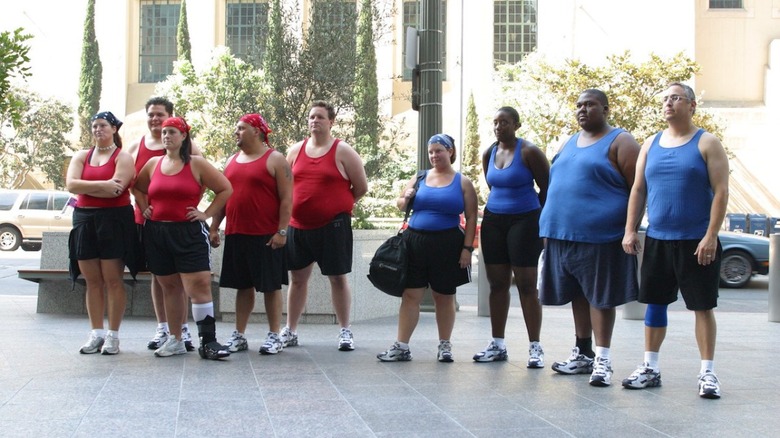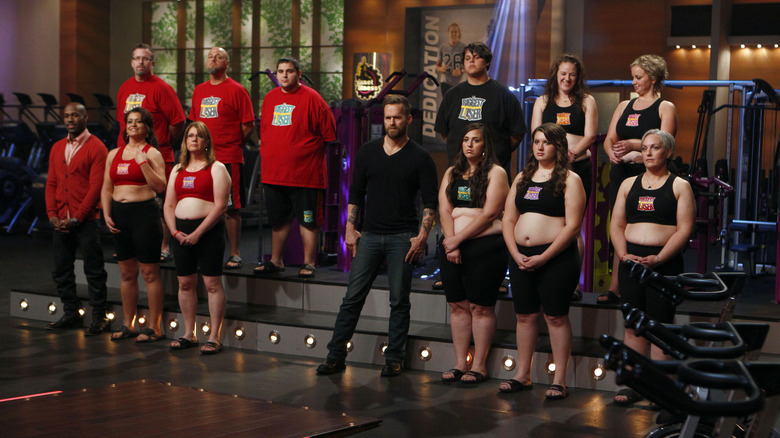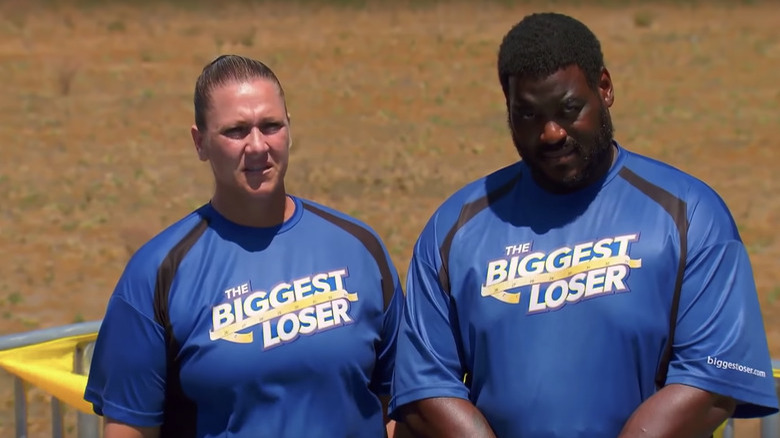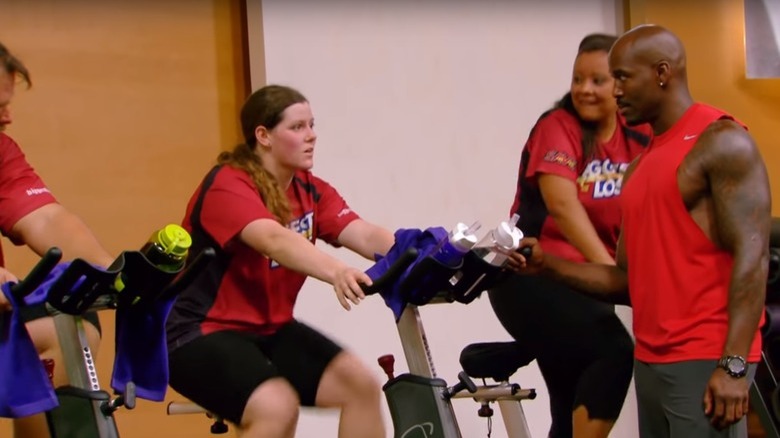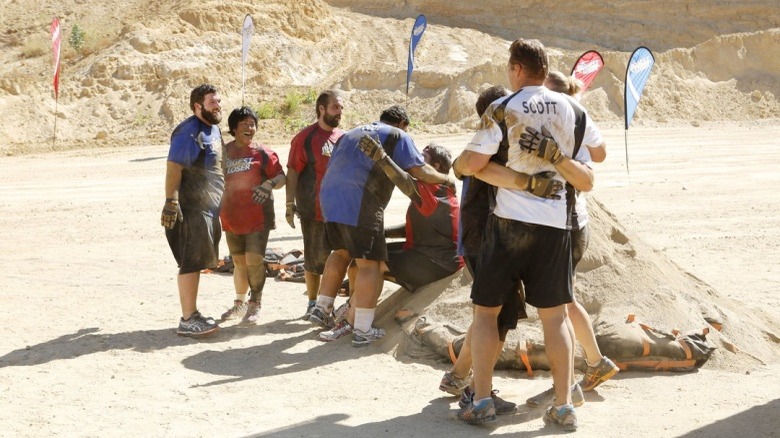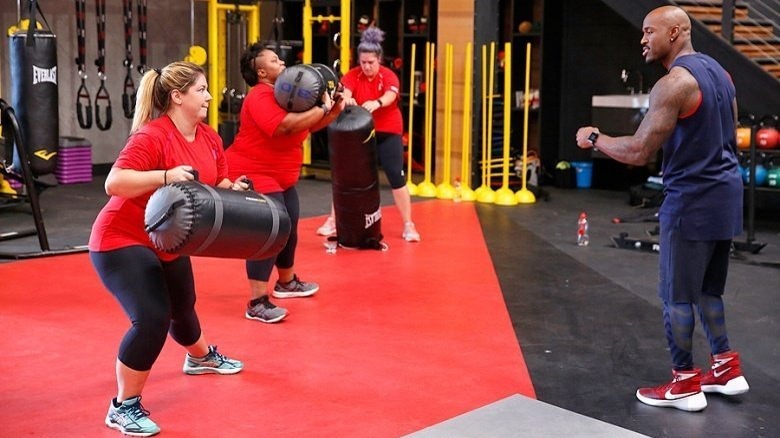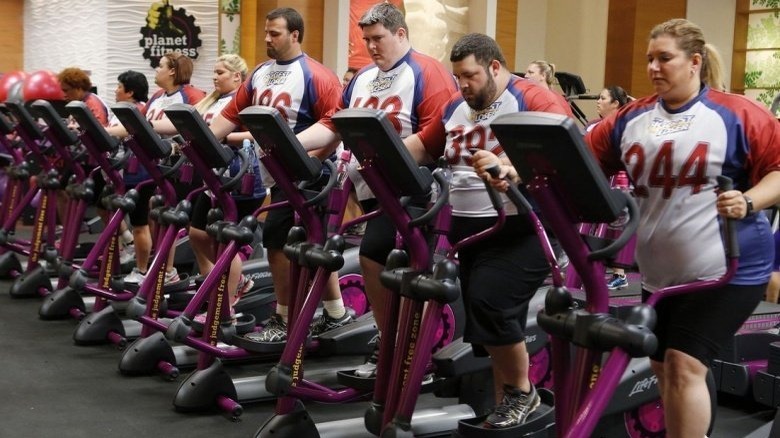The Biggest Loser: False Things You Can Stop Believing About The Show
The Biggest Loser, which debuted on NBC in 2004, was the OG of weight-loss reality television. For 17 seasons, viewers could tune in to see contestants pitted against one another to see who could lose the most weight within a 30-week time frame. At the end of each season, one lucky winner was crowned the biggest loser and took home a substantial cash prize in the amount of $250,000.
But like many reality TV shows, there was a lot more going on behind the scenes than viewers knew about. Additionally, after contestants returned home, they discovered some surprising changes in their bodies — and not good ones. To that end, after being mired in controversy for some time, The Biggest Loser went off the air in 2016. And although it will be returning to the USA Network in 2020, the reboot will make significant changes to make the program safer for competitors.
So what exactly happened on the set of The Biggest Loser that you didn't know about? And what are the things you always believed about the show that turned out to be totally false? Read on to find out!
Women and men were equal on The Biggest Loser
Contestants on The Biggest Loser came from all walks of life, and all started out at different weights. But once the teams that formed in the beginning of the season were dissolved, it was every man and woman for themselves, regardless of their background and gender. On the surface that seems fine, as there can only be one winner, and that's the person who worked the hardest, right?
Actually it's a bit more complicated than that, especially when it comes to gender, according to science. Specifically, according to a study in the journal Diabetes, Obesity, and Metabolism, men lose weight faster than women across the board. The study examined over 2,200 men and women who followed a diet of about 800 calories for eight weeks, and found that men lost 16 percent more weight than women. Talk about unfair!
Perhaps that's why of the 17 winners of The Biggest Loser, 11 of them were men, and only six were women.
After the show, it's easy for contestants of The Biggest Loser to stay trim
Obviously, it takes a lot of work to be successful on the The Biggest Loser, as many contestants see significant weight loss during their tenure on the show — and losing weight isn't easy. You might be tempted to think, then, that once the cameras stop rolling the contestants stay thin, as they now know how to restrict their diets and commit to an intense exercise regimen. Those are some good skills to have!
But alas, the overwhelming majority of the contestants who appear on The Biggest Loser end up re-gaining some — if not all — of the weight they lost on the show, according to an article in The New York Times. For example, Season 8 winner Danny Cahill, who went from 430 pounds to 191 pounds for a total weight loss of 239 pounds, has regained at least 100 pounds since the finale. And Dina Mercado, who went from 248 to 173 pounds now weighs about 206 pounds. Clearly, then, it's not easy to maintain that weight loss.
It's safe to lose the amount of weight contestants do on The Biggest Loser
If you were a regular viewer of The Biggest Loser when it was in its heyday, chances are you believed it was medically safe to lose the drastic amount of weight that contestants do on the show. After all, the show has a medical staff, and certainly NBC wouldn't broadcast a program that promotes behavior that isn't good for you. Well, you would think so.
However, that apparently was not the case, as the weight loss depicted in the show isn't good for your health at all, according to Lynn Darby, a professor of exercise science at Bowling Green State University. "Safe weight loss is one to two pounds per week, and most people find that hard," she explained in an interview with The New York Post. "If you reduce your calories to less than 800 to 1,000 a day, your metabolism will shut down." That's certainly a lot less weight than they were losing on the ranch!
The contestants are given adequate nutritional counseling on The Biggest Loser
It seems like it would be a no-brainer that if you participate in a reality show that's focused on weight loss, you would get extensive nutritional counseling. Perhaps you'd meet with a registered dietitian once a week to learn about healthy foods, as well as how to shop at the grocery store. That way you could maximize your weight loss by becoming more educated about your diet.
But that's not exactly how it went down on The Biggest Loser, according to Season 4 contestant Nicole Michalik. In an interview with The AV Club, she said that the majority of her nutritional counseling was via her trainer, not the show's nutritionist. "In the beginning, the trainers decided what they wanted in the fridge and the freezer," she recalled. "And we were like, 'That's good,' or, 'That's gross.' Eventually [we] figured out what we liked and what we didn't. And they would buy us that." She added that she had no idea how much the foods she was eating cost, either. That... doesn't sound like the best diet advice out there.
The diets presented on The Biggest Loser are healthy
When a person makes the decision go on a diet, that can be done in as healthy or as unhealthy a manner as possible. In order to do so in the former, the Centers for Disease Control and Prevention recommends that you eat plenty of vegetables and fruits, get adequate protein from lean sources, and stay within your recommended caloric intake.
However, the diets that contestants on The Biggest Loser consumed were definitely not healthy, at least by those standards. For one, Season 8 winner Danny Cahill had one egg, two egg whites, half of a grapefruit, and one piece of sprouted grain toast for breakfast, according to The New York Times. Then for lunch, he ate a grilled chicken breast, 10 spears of asparagus, and one cup of broccoli, followed likely by something similar for dinner — clearly not enough food. Bear in mind that he was working out constantly, so there's no way he wasn't starving all of the time.
Additionally, Season 3 contestant Kai Hibbard told the New York Post that their trainers picked her food, which was low in calories but not healthy, like fat-free cheese, sugar-free Jell-O, and sugar-free energy drinks. Would beans and rice really be so bad?
The exercise regimens on The Biggest Loser are sustainable and healthy
There's no shortage of scenes on The Biggest Loser of contestants busting their butts at the gym, whether that's riding stationary bikes, running on treadmills, squatting, or lunging — you name it. And sure, of course exercise is an essential component of The Biggest Loser, as you need to do it to maximize weight loss.
But if you thought that the exercise routines on the show were either sustainable or healthy, then you'd be wrong. For one, Harley Pasternak, a Los Angeles-based trainer who was the first trainer hired on the show, pulled out before they even started filming. That's because he objected to the tactics they wanted him to employ, which included "screaming and yelling" at contestants. "These entertaining scenarios make for great television," he shared in an interview with The Guardian. "But it's not for someone who is concerned with making people healthy." Pushing people until they vomit isn't healthy either.
Additionally, contestants on The Biggest Loser had to exercise for up to eight hours a day, which isn't sustainable for anyone who has a full-time job.
Contestants on The Biggest Loser were weighed weekly on the dot
Arguably some of the most dramatic moments on The Biggest Loser were the weekly weigh-ins, wherein contestants would find out how much progress they'd made. That was especially the case as the end of the season drew near, and viewers would find out who would be moving into the final rounds of the show. Plus, there would be some weeks where contestants dropped an insane amount of weight, leading you to think they were literally working their butts off.
But as it turns out, the weekly weigh-ins didn't actually happen every seven days — far from it, according to Season 3 contestant Kai Hibbard. "Nobody on the show lost 20 pounds in a week," she revealed in an interview with The Guardian. "Once, 'a week' was actually three weeks because of the shooting schedule." So that explains why those big drops would sometimes happen!
This was corroborated by The Biggest Loser contestant Andrew "Cosi" Costello, who told News.com.au that the longest stretch he experienced between weigh-ins was three and a half weeks. Um, that's not even close to weekly.
The Biggest Loser provided a safe space to work out
With all of the trainers and medical staff employed by The Biggest Loser, you'd think that they made sure that the contestants were safe and not put at risk of any kind of injuries while exercising. But the opposite is reportedly true, according to Season 3 contestant Kai Hibbard, who was subjected to super intense workouts right away. "There was no easing into it," she recalled in an interview with the New York Post. "That doesn't make for good TV. My feet were bleeding through my shoes for the first three weeks."
That's just one example, too. Consider also that one of Hibbard's co-competitors was forced to exercise despite having a torn calf and bursitis in both of her knees. Additionally, Season 1 winner Ryan Benson was so malnourished by the end of the show that he was urinating blood — a sign of kidney damage. And in 2009, two contestants had to be hospitalized, including one via airlift.
Many of those injuries have caused lifelong issues for contestants, according to Hibbard. Yikes.
The contestants on The Biggest Loser don't use drugs on the show
According to Dr. Rob Huizenga, the resident doctor for The Biggest Loser, the contestants are under no circumstances supposed to take illicit drugs to aid them in their weight loss. "Contestants are told at the start of the show that there is zero tolerance for any weight-loss drugs," he told the New York Post. "Urine drug screens and the evaluation of serial weights are repeatedly used to flush out possible illicit use." So naturally, you wouldn't suspect that any drug use was going on.
But that doesn't jive with several contestants on The Biggest Loser, who said that they had definitely been given drugs like Adderall to help lose more weight. For one, 2008 contestant Joelle Gwynn said that her trainer had given her yellow and black pills that made her feel "jittery and hyper." Also, Season 2's Suzanne Mendonca said, "People would take amphetamines, water pills, diuretics, and throw up in the bathroom."
Huizenga has since filed a defamation lawsuit against the New York Post for printing these claims, according to The Hollywood Reporter.
Some contestants on The Biggest Loser were just lazy
Regular viewers of The Biggest Loser will tell you that there really were some contestants who just couldn't hack it. Whether it was staying down when they were told to get up or walking when they were supposed to be running as fast as they could, it appeared that a few folks were just not determined enough to work as hard as they could.
Well, that might be the case some of the time, but not every time, according to Biggest Loser contestant Kai Hibbard. On one occasion, she and her fellow contestants were forced to run on a horse track, which she felt was totally dehumanizing. "To protest, I simply walked the course, refusing to run until they asked me to at the end, hopefully ruining the competitive spirit of the challenge," she recalled in an interview with Cracked.
But that backfired, when the show's editors made her look like she was just being lazy instead. "I felt like maybe I'd be able to preserve a little dignity by not running," she continued. "But in retaliation, they acted like I was just too fat and exhausted to finish." Just... wow.
Contestants' metabolisms must be fast after competing on The Biggest Loser
Can going on The Biggest Loser have a long-term impact on a person's metabolism? It certainly doesn't seem like it should, as all that the contestants are doing is eating less and exercising more than they ever have before. That shouldn't wreak too much havoc, right?
Wrong. Unfortunately, going on the show can have an impact on your metabolism — specifically on your thyroid — which can cause changes that make it harder to keep the weight off after the cameras stop rolling, according to a study in the journal Obesity. Specifically, after researchers tested contestants' thyroid levels, they concluded that they had lowered significantly, according to Harvard Medical School. And because your thyroid is responsible for facilitating metabolic function, contestants needed even less calories to sustain their body weight than they did before competing on The Biggest Loser. That is just 100 percent unfair, especially after all of the hard work and effort they put forth.
Contestants' metabolisms returned to normal after being on The Biggest Loser
It's long been established that going on a diet can slow down your metabolism, as noted in an article in The New York Times. To that end, it was expected that the contestants on The Biggest Loser would, in all likelihood, see some slowdown in their metabolisms after the show wrapped up. But eventually, wouldn't their metabolisms recover and resume their normal function, which is how it usually works?
Shockingly enough, researchers found that contestants would never return to their normal metabolic rates after being on The Biggest Loser. Rather, they were permanently altered, which was a total surprise to everyone. It was as if the contestants' own bodies were determined to regain the weight, regardless of their best efforts. "It is frightening and amazing," metabolism expert Dr. Kevin Hall told the newspaper. "I am just blown away."
While the science proved this to be true, the show's Dr. Rob Huizenga questioned if the study's results were legitimate.
Contestants on The Biggest Loser who regained their weight just weren't working hard enough
The contestants on The Biggest Loser also underwent another bodily change that literally made them hungrier all of the time.
Specifically, researchers found that the leptin levels of contestants had plummeted dramatically, according to Harvard Medical School. Leptin, which is also known as the "satiety hormone," is secreted by a person's fat cells and carries a message to the hypothalamus in the brain. The result is that you feel fuller when leptin is doing its job, as your body stops signaling that it's time to eat something. But without enough of it to get the message across, you basically feel like you're constantly starving, even if you've eaten enough.
So if you suspected that The Biggest Loser contestants who regained some or all of their weight were just being lazy and giving into temptation, it's far more complicated than that.
The trainers on The Biggest Loser are the best in the business
It seems logical that the producers of The Biggest Loser would want only the best and brightest talent out there to be trainers on the show. So you'd expect them to have degrees and certifications from the best schools and programs, as well as tons of proven experience helping people slim down.
But for trainer Harley Pasternak, who quit The Biggest Loser before the show began filming, that was not the case at all. "The last straw was when they cast an actress opposite me," Pasternak, who boasts a master's degree in exercise science, said of Jillian Michaels in an interview with The Guardian. While Michaels does have experience and personal training certifications, Pasternak didn't feel that she was an equal: "I was going up against a TV trainer, not a real one." It should also be noted that Pasternak was not the only trainer to say no to the show for "ethical reasons."
